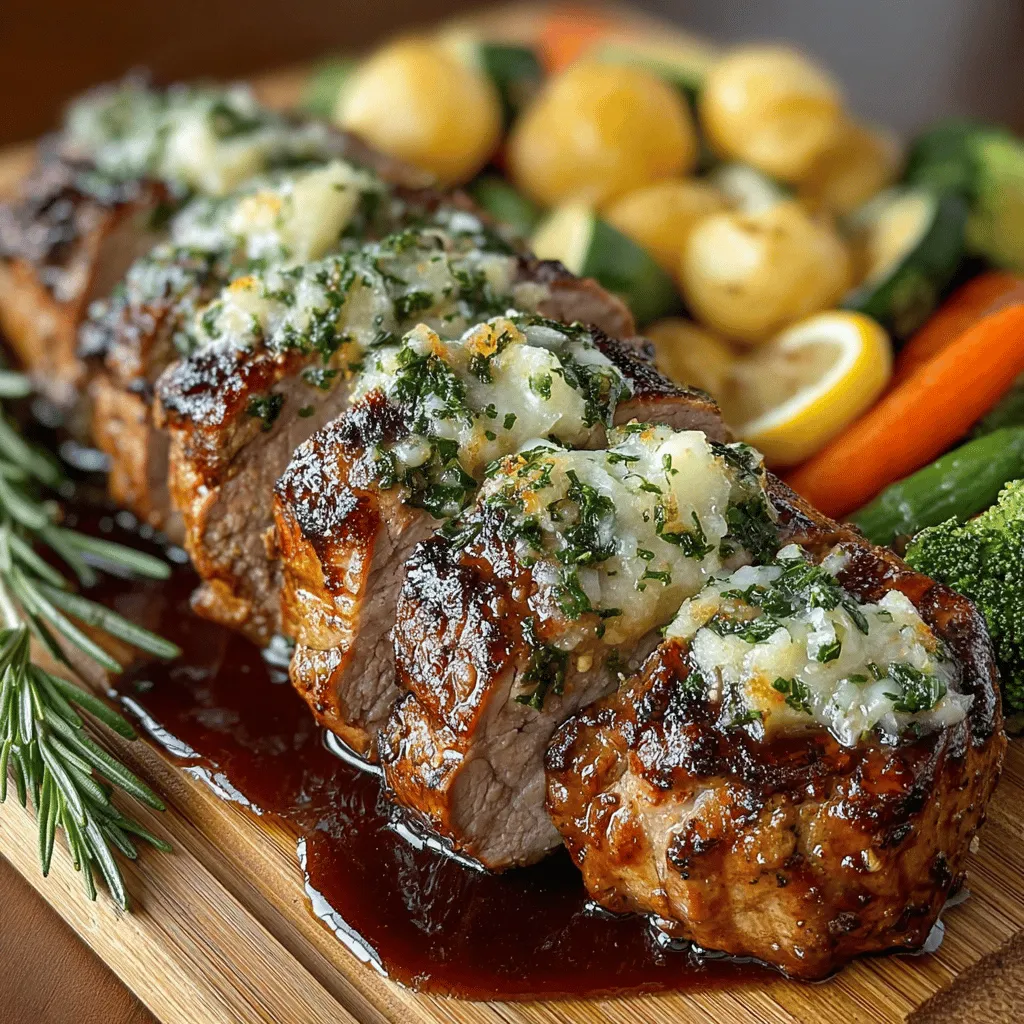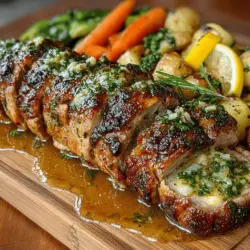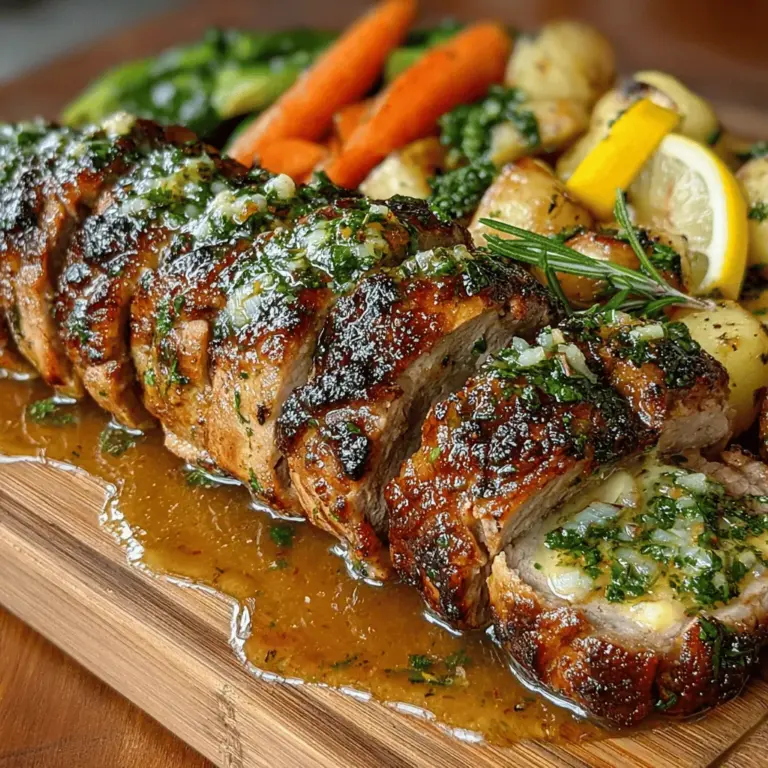Savory Garlic Herb Roasted Pork Tenderloin Recipe
Pork tenderloin is one of the most versatile and lean protein options available, making it a favorite among home cooks and chefs alike. This cut of meat is not only tender but also absorbs flavors beautifully, allowing for a variety of culinary interpretations. In our recipe for Savory Garlic Herb Roasted Pork Tenderloin, we elevate this already delightful dish with a harmonious blend of garlic, fresh herbs, and a hint of citrus. As the pork roasts in the oven, these ingredients meld together, creating an aromatic experience that tantalizes the senses and makes for a perfect centerpiece for any meal.
Roasting is a classic cooking method that enhances the natural flavors of ingredients while ensuring a tender and juicy outcome. The dry heat of the oven caramelizes the exterior of the pork tenderloin, resulting in a beautiful crust, while the interior remains moist and succulent. With our recipe, you’ll learn how to harness the power of roasting to create a dish that is not only delicious but also visually impressive.
Understanding Pork Tenderloin
Before diving into the recipe, it’s essential to understand what pork tenderloin is and why it’s such a prized cut. Pork tenderloin is a long, narrow cut that comes from the muscle along the spine of the pig. Its texture is incredibly tender, and when cooked properly, it offers a mild flavor that pairs well with a wide range of seasonings and sauces.
From a nutritional standpoint, pork tenderloin stands out as a healthy choice. It is low in fat while being high in protein, making it an excellent option for those looking to maintain a balanced diet without sacrificing flavor. A 3-ounce serving of pork tenderloin contains about 23 grams of protein and only about 3 grams of fat, making it a nutritious addition to meals.
When purchasing pork tenderloin, look for a cut that is pinkish-red in color with minimal marbling. The meat should be firm to the touch and free from any off-putting odors. If possible, buy from a reputable butcher or grocery store that sources its meat from high-quality farms, ensuring that your dish will be as flavorful and healthy as possible.
Ingredients Breakdown
The key to making an unforgettable Savory Garlic Herb Roasted Pork Tenderloin lies in the ingredients. Here’s a detailed breakdown of what you’ll need:
– Fresh Herbs: Rosemary, thyme, and parsley are the stars of this dish. Each herb contributes its unique flavor: rosemary adds a fragrant, pine-like essence; thyme offers earthy notes; and parsley provides a fresh, bright finish. Together, these herbs create a complex flavor profile that elevates the pork.
– Garlic: The use of garlic is crucial in this recipe. It brings a rich, savory depth that perfectly complements the tenderness of the pork. Roasting garlic mellows its sharpness, resulting in a sweet and aromatic addition to the dish.
– Olive Oil and Seasonings: Olive oil is not just a cooking fat; it also acts as a carrier for the herbs and spices, helping them to adhere to the meat and infuse it with flavor. Pair it with seasonings like salt and pepper to enhance the natural taste of the pork.
– Lemon Juice and Zest: The brightness of lemon juice and zest adds a refreshing acidity that balances the savory elements of the dish. This citrus component cuts through the richness of the pork, making each bite more enjoyable.
– Chicken Broth: To ensure the pork remains moist during roasting, chicken broth can be added to the roasting pan. It not only keeps the meat juicy but also adds an additional layer of flavor to the dish.
Preparing the Marinade
Now that we have a clear understanding of the ingredients, it’s time to prepare the marinade, which is a crucial step in the cooking process. A well-crafted marinade infuses the pork tenderloin with flavor, while also enhancing tenderness by breaking down the protein fibers.
Step-by-Step Guide to Creating the Marinade:
1. Gather Your Ingredients: In a mixing bowl, combine minced garlic, chopped rosemary, thyme, and parsley. Add the olive oil, lemon juice, and zest, along with salt and pepper to taste.
2. Mix Thoroughly: Whisk the ingredients together until they are well-combined. The mixture should form a cohesive marinade that will coat the pork tenderloin evenly.
3. Marinate the Pork: Place the pork tenderloin in a resealable plastic bag or a shallow dish. Pour the marinade over the meat, ensuring it is well-coated. Seal the bag or cover the dish with plastic wrap.
4. Marinating Times: For optimal results, allow the pork to marinate in the refrigerator for at least 30 minutes. If you have more time, marinating for 2 to 4 hours will yield even better flavor and tenderness. Be cautious not to exceed 24 hours, as the acidity from the lemon juice can begin to break down the meat too much.
By following these initial steps, you’re laying the groundwork for a delicious and satisfying meal. The combination of garlic, fresh herbs, and citrus will create a flavor explosion that makes the pork tenderloin a standout dish at your dinner table. Stay tuned for the next part of the recipe, where we will dive into the roasting process and how to achieve the perfect finish for your savory garlic herb roasted pork tenderloin.

Searing the Pork Tenderloin
Searing is a crucial step in the preparation of savory garlic herb roasted pork tenderloin, as it develops complex flavors and creates an enticing golden crust. This step enhances the overall taste of the pork by caramelizing the natural sugars in the meat, leading to a more robust flavor profile.
To achieve the best results, it is recommended to use a cast iron skillet, which retains heat exceptionally well and distributes it evenly. Begin by heating your skillet over medium-high heat for several minutes until it is hot but not smoking. Add a tablespoon of oil, such as olive oil or vegetable oil, which has a higher smoke point and is ideal for searing.
Once the oil shimmers, carefully place the pork tenderloin in the skillet. Allow it to sear without moving it for about 3-4 minutes, or until a rich golden crust forms. Flip the tenderloin to sear the other side for an additional 3-4 minutes. Avoid overcrowding the skillet, as this can cause the meat to steam rather than sear, preventing that desirable crust from forming.
Timing is key during the searing process. You want to ensure that each side of the meat is browned evenly, which enhances both the texture and flavor. Proper searing locks in juices, ensuring a tender and succulent roast.
The Roasting Process
Once your pork tenderloin is perfectly seared, it’s time to move on to the roasting process. Preheat your oven to 400°F (200°C). This temperature is ideal for roasting, as it allows the outside of the pork to develop a beautiful crust while the inside cooks to a tender and juicy finish.
Roasting not only locks in flavors but also helps maintain moisture within the meat. As the pork cooks, its natural juices mingle with the garlic and herbs, creating a deliciously fragrant dish. During roasting, it is crucial to monitor the internal temperature of the pork to ensure it reaches the ideal doneness of 145°F (63°C). This temperature guarantees that the pork is safe to eat while remaining juicy and flavorful.
To further enhance moisture during the roasting process, you can add a cup of chicken broth to the roasting pan. The broth will create steam in the oven, preventing the pork from drying out and providing a rich base for the pan juices. As the pork roasts, the broth will absorb the flavors from the tenderloin, garlic, and herbs, creating a delectable sauce to serve alongside your dish.
Resting the Meat
After the pork tenderloin has reached the desired internal temperature, it’s essential to allow it to rest before slicing. Resting is a critical step that significantly impacts the juiciness and texture of the meat. During cooking, the juices within the pork move toward the center, and resting allows them to redistribute throughout the meat.
For optimal results, let the tenderloin rest for about 10-15 minutes, tented loosely with aluminum foil to retain warmth. This resting period will ensure that when you slice the meat, you won’t lose those precious juices, resulting in a moist and tender bite.
Covering the pork tenderloin while it rests is important not only for warmth but also for preventing the meat from cooling down too quickly. The residual heat will continue to cook the pork slightly, ensuring that it reaches the perfect texture.
Serving Suggestions
When it comes to serving your savory garlic herb roasted pork tenderloin, presentation is key. Begin by slicing the tenderloin into medallions, about 1-inch thick. This not only makes for an elegant presentation but also allows the beautiful, juicy interior to be showcased.
For a complete meal, consider pairing the pork with complementary side dishes. Roasted vegetables, such as carrots, Brussels sprouts, or asparagus, provide a vibrant touch and contribute additional flavor. A bed of fluffy rice or creamy mashed potatoes can also serve as a great base for the pork, soaking up the delicious pan juices.
Don’t forget to drizzle the pan juices over the sliced pork before serving. This adds an extra layer of flavor and elevates the overall dish. The combination of garlic, herbs, and the natural flavors from the roasted meat will create a mouthwatering experience for your guests.
Conclusion
The savory garlic herb roasted pork tenderloin recipe is not only simple to prepare but also bursting with flavor, making it an excellent choice for family meals or entertaining guests. With its succulent meat and aromatic garlic and herbs, this dish is sure to impress everyone at the table.
Moreover, cooking with fresh ingredients allows you to create a meal that is both satisfying and healthy. The balance of flavors, combined with the ease of preparation, makes this recipe a must-try for anyone looking to elevate their home cooking.
Embrace the joy of cooking with fresh ingredients, and savor the satisfaction of a well-executed home-cooked meal. Whether you are sharing this dish with loved ones or enjoying it during a quiet evening at home, the savory garlic herb roasted pork tenderloin is guaranteed to become a favorite in your culinary repertoire.

